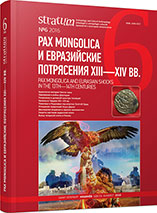Исторические и архитектурные метаморфозы Шейх-Коя
Historical and Architectural Metamorphosis of Sheikh Koy
Author(s): Sergei Gennadievich Bocharov, Vladimir P. KirilkoSubject(s): History, Archaeology, Fine Arts / Performing Arts, Architecture, Middle Ages, 13th to 14th Centuries
Published by: Издательский дом Stratum, Университет «Высшая антропологическая школа»
Keywords: Crimea; Golden Horde; Eastern sedentary population; Sufi monastery; Seljuk art; architecture of the Crimean Khanate; mosque; portal; mihrab; muqarnas
Summary/Abstract: The early settlements of the Golden Horde in the Crimea were founded by migrants from the East, and most of them are still poorly investigated. Almost all of them, from the ones we know, are quite compactly concentrated within two clearly markеd zones — in the south-east (Solkhat, Sudak, Otuz) and south-west (Eski Yurt, Kyrk-Er) of the Crimean Peninsula. The least researched are the Golden Horde architectural and archaeological settlement sites in the Central Crimea. This publication is the first attempt to at least partially address this imbalance. An example of a key object of research — the mosque in Sheikh Koy (now Davydovo village, Simferopol district) — demonstrates the processes associated with the creation and collapse of the Golden Horde, as this mosque belongs to the time of the Crimean Khanate, and its construction was conditioned by the historical heritage of the previous era, partly reflected in the secondary use of architectural details, which originally belonged to a structure of 1358. Most likely, Sheikh Koy and the nearest villages Barak-Eli and Choyundzhi, housed a major religious and Sufi center — one of the four known areas, dating to the first stage of dissemination of Islam in the Crimean Peninsula.
Journal: Stratum plus. Археология и культурная антропология
- Issue Year: 2016
- Issue No: 6
- Page Range: 371-392
- Page Count: 22
- Language: Russian
- Content File-PDF

